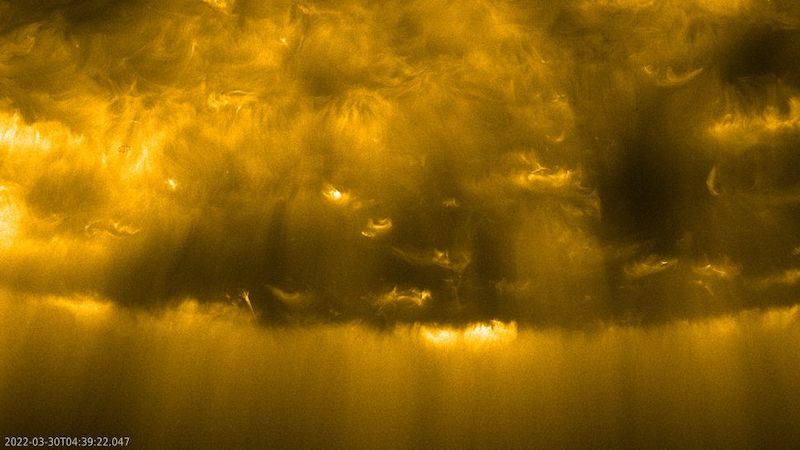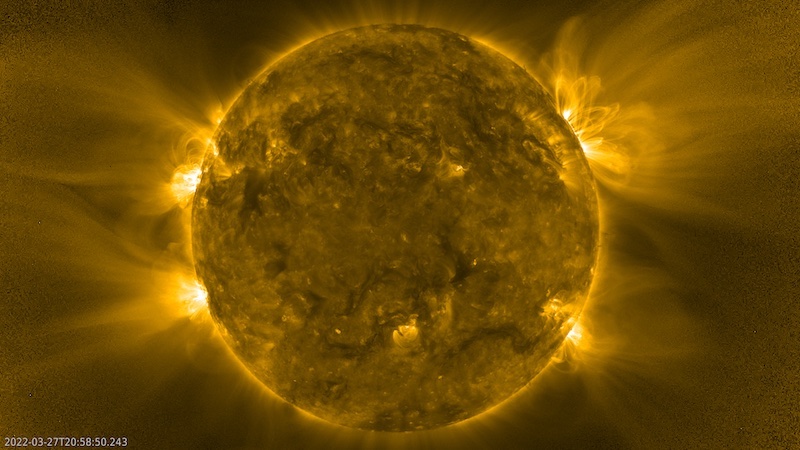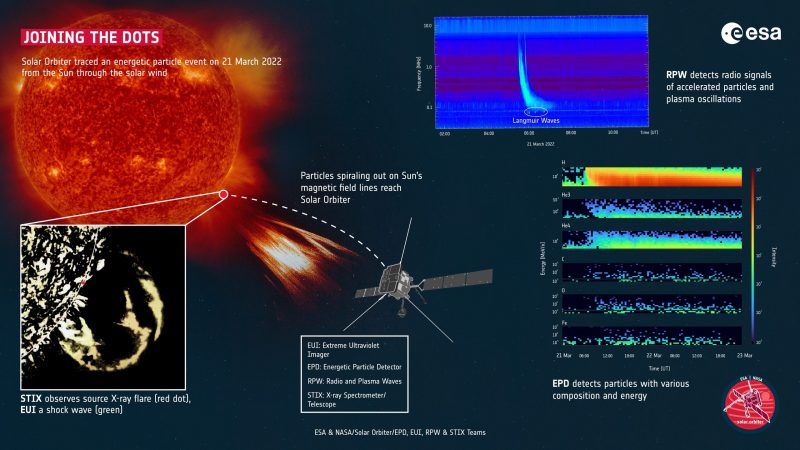
Originally published on May 18, 2022, at ESA – European Space Agency.
The sun in amazing images by Solar Orbiter
Powerful flares, breathtaking views across the solar poles, and a curious solar hedgehog are among the haul of spectacular images, movies and data returned by Solar Orbiter from its first close approach to the sun. Although the analysis of the new dataset has only just started, it is clear that the ESA-led mission is providing extraordinary insights into the sun’s magnetic behavior and the way this shapes space weather.
Solar Orbiter’s closest approach to the sun, known as perihelion, took place on March 26, 2022. The spacecraft was inside the orbit of Mercury, at about 1/3 the distance from the sun to the Earth, with its heatshield reaching around 900° F (500° C). But it dissipated that heat with its innovative technology to keep the spacecraft safe and functioning.

Solar Orbiter uses 10 science instruments to observe the sun
Solar Orbiter carries 10 science instruments all working together in close collaboration to provide unprecedented insight into how our local star works. Some are remote-sensing instruments that look at the sun, while others are in-situ instruments that monitor the conditions around the spacecraft. This enables scientists to join the dots from what they see happening at the sun to what Solar Orbiter feels at its location in the solar wind millions of miles away.
When it comes to perihelion, clearly the closer the spacecraft gets to the sun, the finer the details the remote sensing instrument can see. And as luck would have it, the spacecraft soaked up several solar flares and an Earth-directed coronal mass ejection. Solar Orbiter also provided a taste of real-time space weather forecasting, which is becoming increasingly important because of the threat space weather poses to technology and astronauts.

Introducing the solar hedgehog
The task now for scientists is to understand what they’re seeing. This is a challenge, because Solar Orbiter is revealing so much activity on the sun at such a small scale. Having spotted a feature or an event that they can’t immediately recognize, scientists must then dig through past solar observations from other space missions, looking to see if it’s been imaged before.
One particularly eye-catching feature from the perihelion pass is something they’ve nicknamed the hedgehog. It stretches 15,000 miles (25,000 kilometers) across the sun and has a multitude of spikes of hot and colder gas that reach out in all directions.
David Berghmans, at the Royal Observatory of Belgium, is the principal investigator of the Extreme Ultraviolet Imager instrument which takes high-resolution images of the lower layers of the sun’s atmosphere, known as the solar corona. This region is where most of the solar activity that drives space weather takes place. Berghmans said:
The images are really breathtaking. Even if Solar Obiter stopped taking data tomorrow, I would be busy for years trying to figure all this stuff out.

Connecting the dots
Solar Orbiter’s main science goal is to explore the connection between the sun and the heliosphere. The heliosphere is the large bubble of space that extends beyond the planets of our solar system. It is filled with electrically charged particles, most of which have been expelled by the sun to form the solar wind. It is the movement of these particles and the associated solar magnetic fields that create space weather.
To chart the sun’s effects on the heliosphere, the particles and magnetic fields that sweep across the spacecraft must be traced back to events on or near the visible surface of the sun.
This is not an easy task as the magnetic environment around the sun is highly complex. But the closer the spacecraft can get to the sun, the less complicated it is to trace particle events back to the sun along the highways of magnetic field lines. The first perihelion was a key test of this, and the results so far look very promising.

The sun’s magnetic field
When it comes to the magnetic field, it all begins at the sun’s visible surface, known as the photosphere. This is where the internally generated magnetic fields burst into space. The Solar Orbiter carries instruments that can see the north and south magnetic polarity on the photosphere. It can also see the rippling of the sun’s surface due to seismic waves traveling through its interior.
Another instrument records the composition of the corona. Scientists can compare these abundance maps to the contents of the solar wind that the Solar Wind Analyser instrument views.
By combining data from all instruments, the science team will be able to tell the story of solar activity from the surface of the sun, out to Solar Orbiter and beyond. And that knowledge is exactly what will pave the way for a future system designed to forecast the space weather conditions at Earth in real time. In the lead-up to perihelion, Solar Orbiter even got a taste of how such a system might operate.

Studying space weather
The spacecraft was flying upstream of Earth at perihelion. This unique perspective meant that it was monitoring the conditions of the solar wind that would hit Earth several hours later. Since the spacecraft was in direct contact with the Earth, with its signals traveling at the speed of light, the data arrived on the ground within a few minutes, ready for analysis. As luck would have it, there were several coronal mass ejections detected around this time, some of them heading directly for Earth.
Bottom line: ESA’s Solar Orbiter reached perihelion, its closest point to the sun, in March. Here are stunning closeup images as never seen before.











